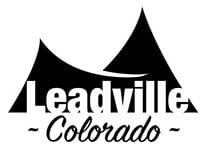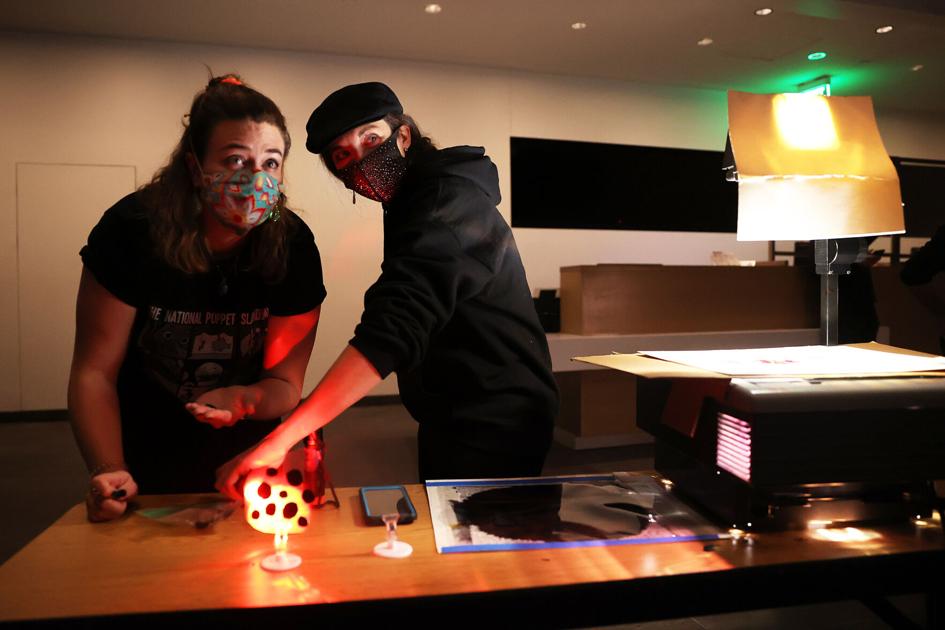Shadow puppetry is afoot in the darkened lobby of Ent Center for the Arts.
A masked puppeteer works quickly, moving projector sheets back and forth and up and down as he stands behind an old-school overhead projector. He creates giant moving animal shapes on a huge white screen made of butcher paper that covers the south-facing wall of the building.
Another puppeteer works a few feet away. Clothed in black from head to toe, she crouches in a half-lunge, using a flashlight to illuminate puppet silhouettes to match the narration of the story coming from a nearby laptop.
They’re rehearsing Theatreworks’ upcoming production of “The Mitten,” a shadow puppet adaptation of a Ukrainian folk tale about a boy’s lost mitten in the forest.
“It’s this unique art form,” says show co-director Katy Williams, a puppeteer who owns the Denver-based Katy Williams Designs and teaches puppetry, props and makeup design. She grew up in Manitou Springs.
“My favorite part is bringing a thing to life. You take something inanimate and puppeteer it in order to bring it to life so that folks don’t recognize the puppeteer is even there anymore.”
When most think of puppets, chances are they conjure up Kermit the Frog or Bert and Ernie. But there’s more to puppetry than Oscar the Grouch.
“The Mitten,” a family-friendly collaboration among Theatreworks, Katy Williams Designs and JParker Arts, opens Friday. It runs Friday through Sunday and Feb. 26-28.
Because of the pandemic, the 30-minute show will be outdoors. Groups of no more than a dozen will meet at the scene shop behind the Ent Center and be guided through stations around the perimeter of the building. At each stop, they’ll watch a three- to four-minute shadow puppet vignette as it’s created live inside the building. Prerecorded narration by local voice actors and an original score by Colorado Springs musician and composer Sean Hennessy will be heard through Bluetooth speakers.
“It’s like a moving book with narration,” says Theatreworks’ artistic director Caitlin Lowans, who was motivated to collaborate with Williams and Julie Parker, owner of Denver-based JParker Arts, after seeing “The Shadows of Sleepy Hollow,” their shadow puppet version of “The Legend of Sleepy Hollow,” last fall in Englewood. “The artistry and inventiveness in the time of COVID-19 is inspiring.”
It’s not an easy process to build a shadow puppet show. Williams and Parker put together the storyboards, then gave them to Lowans, who created a script based on the folk tale. A designer then drew the puppets. The most challenging part, says Williams, is understanding the concept of negative space with the shadow puppets and creating an interesting silhouette. From there, puppets are cut out by hand or laser and go on little stands or onto overhead projector sheets to be used in either flashlight puppetry or front-facing shadow puppetry. The show will feature 60 to 70 puppets.
“They’re not as big as you think,” Lowans says. “Oftentimes the puppets are 6 or 12 inches tall. It’s the distance between the puppets and the light source and screen that play with scale. A 6-inch puppet placed the right distance from a screen can create a 6-foot or 16-foot shadow with some powerful flashlights. One delightful thing is how something small can create a large storytelling impact.”
Each scene is staffed with one to three puppeteers, who are graduates or students at University of Colorado at Colorado Springs. For those without much puppeteering experience, Williams and Parker have taught them to move the puppets to achieve the proper effects. Learning the basic skills isn’t hard, says Williams, but understanding depth perception and how to work with the light is tricky.
On this particular rehearsal night, puppeteer S.b. Parks is responsible for the first scene. She runs through it repeatedly, focusing intently on getting the puppet cutouts to interact coherently on screen, all while keeping up with the narration. Williams and Parker applaud her when each run-through ends.
“You don’t get to see shadow puppetry much,” Parker says. “And it’s the oldest form of puppetry in the world.”
If the idea of a puppet show doesn’t resonate, Williams understands — she’s encountered many a puppet naysayer in her line of work. But she asks you to reconsider.
“I say, ‘What kind of puppets have you seen?’ and they usually say the Muppets or ‘Sesame Street,’ and I say, ‘Totally valid,’” she says. “I show them shadow puppetry or weird suitcase puppets I call Crankies — all these things that fit into the world of puppetry, but people wouldn’t have considered them puppets. Like (the 1993 film) ‘The Nightmare Before Christmas’ — that’s puppetry. We’re opening that world up to people.”
Contact the writer: 636-0270
This content was originally published here.

